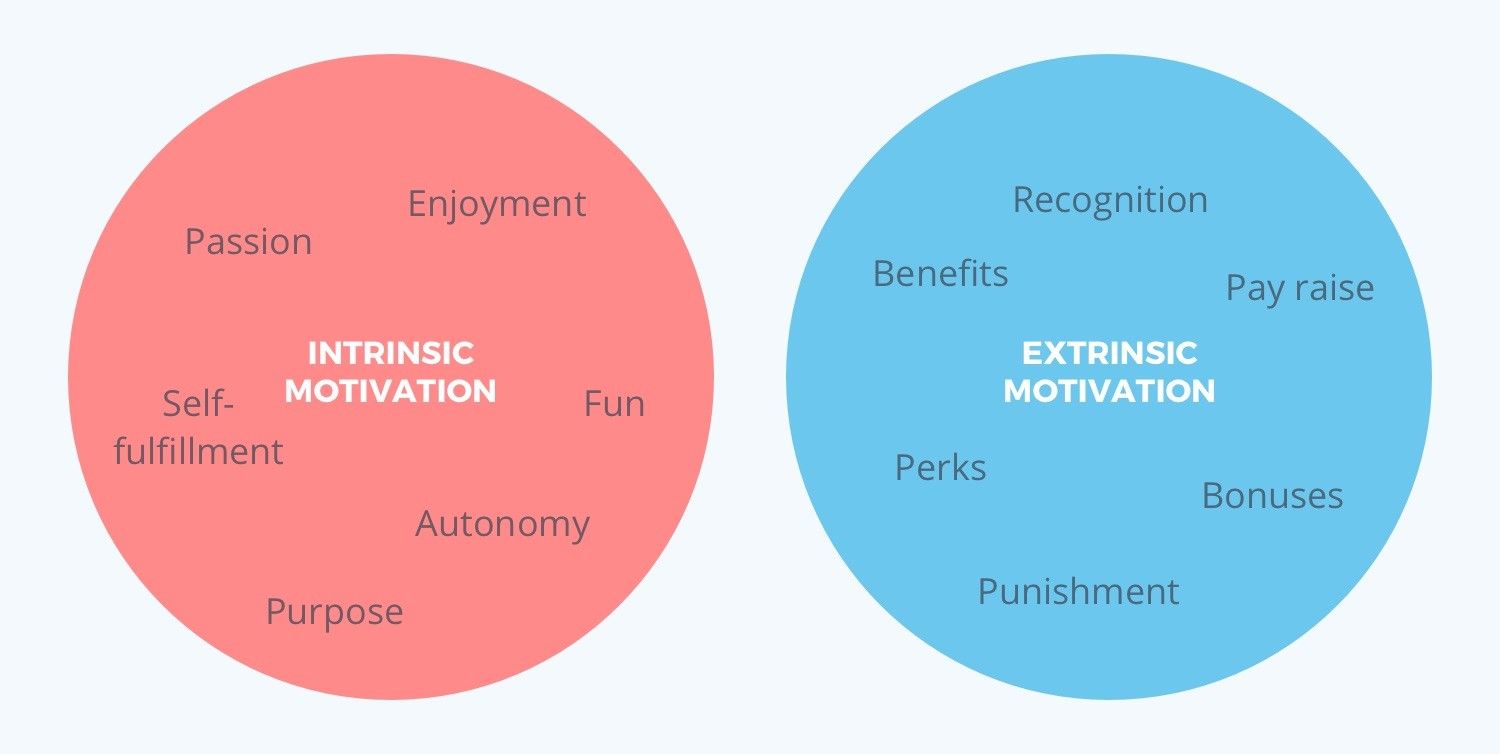Exploring the Hidden Forces of Intrinsic and Extrinsic Motivation

Motivation is a fascinating force that drives us to take action, pursue our goals, and experience personal growth. However, not all motivation is created equal.
Intrinsic and extrinsic motivation are two distinct forms that can significantly impact our drive, satisfaction, and overall success. In this article, we will delve into the science behind intrinsic and extrinsic motivation, explain their differences, and explore practical ways to apply this knowledge in your own life. So, get ready to dive deep into the world of motivation and discover how you can unlock your inner drive!
Understanding Intrinsic and Extrinsic Motivation:
To grasp the concept of intrinsic and extrinsic motivation, let's start by defining them.
Intrinsic motivation refers to the internal desire and enjoyment we experience when engaging in an activity for its own sake. It is driven by personal satisfaction, curiosity, and a sense of accomplishment.
Extrinsic motivation comes from external factors such as rewards, recognition, or punishment. It involves performing an activity to attain something outside of the activity itself.

The Science Behind Motivation:
The impact of intrinsic and extrinsic motivation goes beyond surface-level understanding. When our innate psychological needs are fulfilled, we experience a profound effect on our engagement, satisfaction, and overall well-being.
- Autonomy: The need for autonomy refers to our desire for independence, choice, and control over our actions. When we engage in activities that align with our personal interests and values, we feel a sense of autonomy. Intrinsic motivation flourishes in situations where we have the freedom to make decisions, set our own goals, and follow our passions. By honoring our need for autonomy, we cultivate a strong sense of motivation that stems from within.
- Competence: The need for competence relates to our desire to feel capable, competent, and effective in what we do. When we engage in activities that challenge us at an appropriate level, allowing for growth and skill development, we experience intrinsic motivation. Achieving mastery and experiencing progress boosts our self-confidence and fuels our intrinsic drive. By seeking opportunities that challenge and stretch our abilities, we enhance our sense of competence and motivation.
- Relatedness: The need for relatedness reflects our fundamental drive to connect with others, feel a sense of belonging, and experience meaningful relationships. Intrinsic motivation thrives when we engage in activities that foster social connections and promote a sense of community. Collaborating with like-minded individuals, receiving support and encouragement, and sharing experiences enhance our intrinsic motivation. By cultivating a supportive environment that nourishes our need for relatedness, we create a fertile ground for intrinsic motivation to flourish.
However, it's important to recognize that extrinsic motivation can also play a role in driving behavior change and providing external incentives. External rewards, such as praise, recognition, or tangible prizes, can initially stimulate motivation and encourage us to take action. They can be particularly effective in initiating new behaviors or tasks.
Yet, overemphasis on extrinsic rewards can have unintended consequences. When external rewards become the primary focus, our intrinsic motivation may diminish. The enjoyment and satisfaction derived from the activity itself take a backseat to the desire for the reward. Consequently, our long-term commitment and satisfaction decline, as the joy of the activity becomes overshadowed by extrinsic incentives.
Striking a balance between intrinsic and extrinsic motivation is key. Rather than relying solely on external rewards, we can use them strategically to support and reinforce our intrinsic drive. By using extrinsic motivators as occasional boosts rather than the sole source of motivation, we can maintain our internal enjoyment, engagement, and long-term commitment.
Applying Intrinsic and Extrinsic Motivation:
Now that we understand the science behind intrinsic and extrinsic motivation, let's explore tangible ways to apply this knowledge in our lives:
- Identify Your Motivators: Take some time to reflect on the activities that truly drive and fulfill you. Are they primarily fueled by intrinsic or extrinsic motives? Understanding your own motivators can help you align your goals and pursuits with your authentic desires.
- Cultivate Intrinsic Motivation: Find ways to make tasks and activities more personally rewarding. Set meaningful goals, focus on personal growth, and find deeper purpose in what you do. Seek out opportunities to challenge yourself and develop new skills.
- Use Extrinsic Motivation Strategically: While external rewards can be helpful in initiating behavior change, be mindful of their long-term impact. Instead of relying solely on external incentives, use them strategically to support and reinforce your intrinsic motivation.
- Foster Autonomy: Seek opportunities to exercise autonomy and make choices in your endeavors. When you have a sense of control and ownership over your actions, you are more likely to be intrinsically motivated. Set your own goals, explore different approaches, and experiment with creative solutions.
- Build a Supportive Environment: Surround yourself with individuals who share similar passions and goals. Join communities or groups related to your interests, collaborate with others, and seek social support. Connecting with like-minded individuals can enhance intrinsic motivation through shared experiences and encouragement.
Intrinsic and extrinsic motivation are powerful forces that shape our drive and determine our level of satisfaction in pursuing our goals.
By understanding the science behind these motivations and applying them strategically, you can unlock your inner drive and achieve greater personal fulfillment. Embrace the joy of the journey, cultivate intrinsic motivation, and use external rewards wisely to optimize your path to success.
Remember, motivation is not just a destination; it's a lifelong journey of growth and self-discovery.

Reflection:
As we conclude this exploration of intrinsic and extrinsic motivation, I invite you to reflect on your own motivations and delve deeper into understanding the dynamics at play in your life.
Here are a few thought-provoking questions to guide your introspection:
- What activities or goals in your life bring you the greatest joy and fulfillment? Can you identify whether they are primarily driven by intrinsic or extrinsic motivation?
- Reflect on moments when you have felt the most engaged and satisfied in an activity. Were you motivated by a sense of personal enjoyment, curiosity, or a desire for external rewards?
- Consider a time when you experienced a shift in motivation. Did an initially intrinsic motivation become more extrinsic over time, or vice versa? What factors influenced this shift?
- How can you nurture your intrinsic motivation and align your pursuits with your authentic desires? Are there ways to infuse more autonomy, competence, or relatedness into the activities that matter most to you?
- Examine the role of external rewards in your life. Are there areas where you rely heavily on extrinsic motivators? How might you strategically use these rewards to support and reinforce your intrinsic motivation rather than overshadowing it?
By taking the time to reflect on these questions, you can gain valuable insights into your own motivations and determine whether they stem from within or are influenced by external factors.
Understanding this distinction empowers you to make conscious choices about how to optimize your drive and find greater satisfaction in pursuing your goals.
Remember, motivation is a deeply personal and evolving aspect of our lives. Embrace the journey of self-discovery and continuously reassess your motivations to ensure they align with your true passions and aspirations.